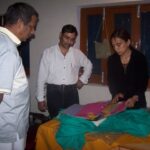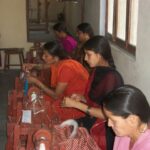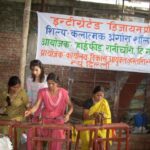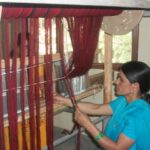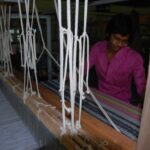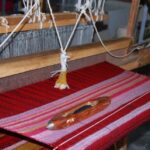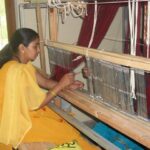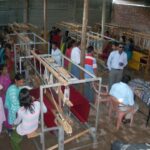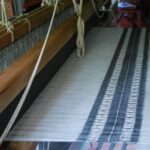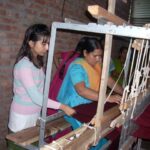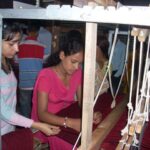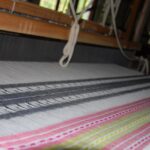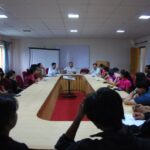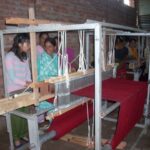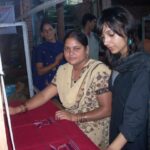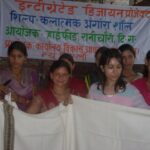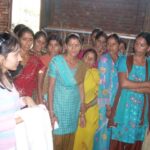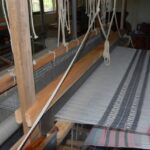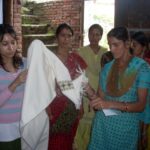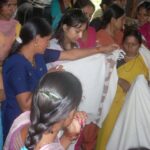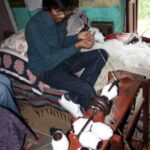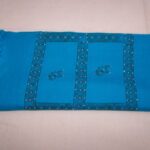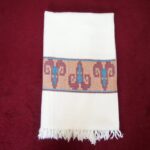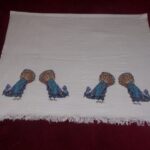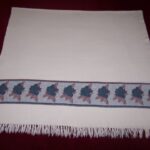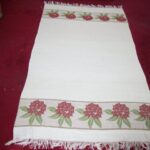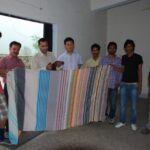ARTISTIC ANGORA SHAWL PRODUCTION
ARTISTIC ANGORA SHAWL PRODUCTION IN CHAMBA BLOCK OF DISTRICT TEHRI GARHWAL OF UTTARAKHAND UNDER AMBEDKAR HASTSHILP VIKAS YOJANA
INTRODUCTION AND BACKGROUND OF THE PROJECT
Handicrafts, a dynamic facet of our economy, have assumed a pivotal role within the decentralized and unorganized sector. Originating as modest endeavours in rural landscapes, they have metamorphosed into a thriving economic venture, galvanized by burgeoning market demand. A quintessential example of their latent potential lies in their role as sustenance providers for countless artisans across the nation, offering an open avenue for newcomers to partake in the craft. Despite their far-reaching significance, this sector grapples with formidable challenges that include limited access to education, capital, exposure to innovative technologies, market insights, and the presence of a fragile institutional framework. In response to these hurdles, the Artisanal Heritage and Village Industries Yojana (AHVY) emerged as a transformative intervention. Anchored in a project-based, need-centric paradigm, AHVY strives for the holistic advancement of potential handicraft clusters.
This visionary scheme extends a comprehensive support package to enclaves of skilled artisans, encompassing fundamental inputs, robust infrastructure augmentation, and skill enrichment, all strategically aligned to captivate targeted markets. The crowning objective of this endeavour remains the empowerment and enduring sustainability of these artisans, underscoring the inclusivity that defines its vision. Despite substantial governmental interventions that have orchestrated the revival and resilience of crafts over the last few decades, the handicraft sector beckons for more fortified fortification to attain global competitiveness. Thus, the advent of a freshly ratified scheme, hinged on a cluster-centric methodology, embarks on a noble quest to bridge critical gaps and address the pressing demand for global market dominance. This pioneering stride not only acknowledges the historical essence of handicrafts but also lays the foundation for their resounding success in the dynamic global arena.
AIMS AND OBJECTIVES OF THE PROJECT
1. Establish self-reliant Community Based Enterprises (CBEs) by organizing artisans, thereby promoting empowerment and self-sufficiency through the principles of cooperation and self-help.
2. Empower women artisans and non-artisan women through micro-credit initiatives and alternative income generation activities, thus nurturing economic independence and facilitating their inclusion within the financial framework.
3. Create artisan clusters and self-help groups (SHGs) to engender economic engagement and sustainable progress, encouraging artisans to collaborate and provide mutual support.
4. Elevate artisans to the role of active entrepreneurs and pivotal stakeholders, facilitating their access to both domestic and international markets, thus propelling visibility and expansion.
5. Augment artisan competencies via design and technology interventions, enabling the utilization of superior-quality raw materials, tools, and equipment to drive value-added production.
6. Deliver infrastructural support aimed at heightening the quality and productivity of artisanal production, ultimately expanding avenues for entry into larger domestic and international markets.
7. Advocate for collective participation among all members throughout the production and marketing phases, thus propelling growth across human resources, production capacities, business undertakings, and overall income, consequently fostering sustained development.
COMPONENTS AND ACTIVITIES OF THE PROJECT
1. Foster awareness of self-help and community participatory organizations by conducting motivational and awareness camps coupled with training sessions.
2. Establish shared work centers to effectively manage raw materials, wages, marketing activities, and value realization in a streamlined manner.
3. Enhance artisan capabilities through targeted skill development programs, emphasizing the refinement of technical skills, product quality, and design proficiency.
4. Create a centralized common facility center at the block or cluster level, providing access to shared infrastructure and equipment, thereby enhancing overall productivity.
5. Encourage product diversification and the cultivation of innovative designs by organizing workshops and seminars focused on design principles.
6. Extend financial assistance to artisans in the form of margin money or working capital, facilitating their access to essential financial resources for entrepreneurial pursuits.
7. Establish dedicated emporiums and marketing outlets to both showcase and retail artisan products, thereby expanding market penetration and cultivating stronger customer connections.
TARGET AREA OF THE PROJECT
The project was strategically executed within a delimited geographic expanse encompassing 16 villages situated within the Chamba block of Tehri Garhwal district. The selection of this target area was meticulously based on specific criteria, including the concentration of artisans possessing distinct craft skills, the existence of a market for their products, and the discernible potential for sustainable growth and development.
TARGET GROUPS AND BENEFICIARIES OF THE PROJECT
The project’s recipients consisted of approximately 225 artisans, carefully selected from the designated villages within the project’s purview. These artisans were effectively mobilized and structured into self-help groups (SHGs), facilitating collaborative efforts and mutual support in pursuit of their individual economic endeavours.
FUNDING PARTNER OF THE PROJECT
The project was funded by Development Commissioner (Handicrafts), Ministry of Textiles, Government of India, New Delhi.
SANCTIONED BUDGET OF THE PROJECT
The budget for the project was sanctioned by the DC (Handicrafts) in accordance with the details provided below:
| Financial Year | Sanction Order/Work Order/Agreement No. | Date of Sanction Order/Work Order/ Agreement |
Sanctioned Budget of the Project (Amount in Rs.) |
| 2008-09 | F. No. C- 14011/ 31/2007-08- CC (CR) | 21.02.2008 | 90,000.00 |
| 2009-10 | F. No. C- 14011/ 31/2007-08- CC (CR) (1) | 03.09.2009 | 3,60,000.00 |
| 2009-10 | F. No. C- 14011/ 31/ 2007-08- CC (CR) (2) | 03.09.2009 | 10,00,000.00 |
| 2009-10 | F. No. C- 14011/ 31/2007-08- CC (CR) (3) | 03.09.2009 | 7,24,000.00 |
| 2010-11 | F. No. C- 14011/ 31/2007-08- CC (CR) (1) | 13.09.2010 | 3,60,000.00 |
| 2010-11 | F. No. C- 14011/ 31/2007-08- CC (CR) (2) | 13.09.2010 | 3,62,000.00 |
| 2010-11 | F. No. C- 14011/ 31/2007-08- CC (CR) (3) | 13.09.2010 | 2,00,000.00 |
| Total | 30,96,000.00 |
OUTCOMES AND ACHIEVEMENTS OF THE PROJECT
The Artistic Angora Shawl Production Project has been successful in achieving its objectives, and the following outcomes and achievements have been accomplished:
1. Groups of artisans have been successfully organized into self-reliant and user-friendly Community Based Enterprises (CBEs) based on the philosophy and principles of self-help and cooperation.
2. Awareness of self-help and community participative organizations has been developed through motivation and awareness camps-cum-trainings based on homogeneity and affinity factors.
3. Women artisans and non-artisan women members of the community have been empowered through micro-credit operations and alternative income generation activities, while integrating the artisan’s community through bonds of solidarity established through women thrift & credit operations.
4. Artisans clusters have been organized into self-help groups (SHGs) with a view to enabling them to take up economic activity for sustainable development through a collective mode.
5. Artisans have been empowered by making them active entrepreneurs cum primary stakeholders in the process of development and bringing them to a visible platform for easy access to domestic and overseas markets.
6. Artisan’s skills have been upgraded through appropriate design and technology intervention, enabling them to use quality raw material, tools, and equipment to produce value-added items.
7. Adequate infrastructure support has been provided for improved quality and productivity, and artisans can access a larger market segment, both domestic and international.
8. Common work centers have been established at the village/area level for managing raw material supply, wages, marketing, and value realization.
9. Skills of artisans have been upgraded, and a common facility center has been established at the block/cluster level for diversifying product development and design.
10. Design workshops and seminars have been organized to assist artisans with margin money/working capital, and emporiums and marketing outlets have been established to promote and market artisan products.




